B0041VYHGW EBOK (82 page)
Authors: David Bordwell,Kristin Thompson

The zoom lens can also be used to provide a mobile framing while the camera stays fixed. How can we as viewers distinguish between a zoom and a tracking or craning movement? In general, animation, special effects, and the zoom lens reduce or blow up some portion of the image. Although the tracking shot and the crane shot do enlarge or reduce portions of the frame, this is not
all
that they do. In the genuine camera movement, static objects in different planes pass one another at different rates. We see different sides of objects, and backgrounds gain volume and depth.
In Alain Resnais’s
La Guerre est finie,
a tracking shot
(
5.140
,
5.141
)
gives the objects considerable volume. The wall has lost none of its bulk or solidity. Moreover, the street sign has not simply been enlarged. We also see it from a distinctly different angle.

5.140 In
La Guerre est finie,
a street sign tilted slightly up on its right side …
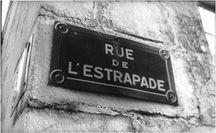
5.141 … is tilted up distinctly at the left by the end of the track-in.
In contrast, with a zoom enlargement, the mobile frame does not alter the aspects or positions of the objects filmed. In
5.142
and
5.143
, from Theo Angelopoulos’s
Ulysses’ Gaze,
a zoom enlarges our view of a large, broken statue of Lenin floating on a barge. Our vantage point on the statue is the same at the end of the shot as at the beginning: The top of the statue is still seen against the bottom of a row of small trees, and its feet are in exactly the same place in relation to the railing on the ship’s prow. As the zoom occurs, the barge gradually looks closer to the line of trees than it had at the beginning. In sum, when the camera moves, we sense our own movement through the space. In a zoom, a bit of the space seems magnified or demagnified.
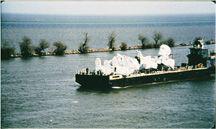
5.142 A distant view of a statue on a barge in
Ulysses’ Gaze
…
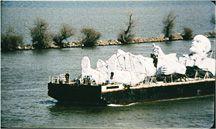
5.143 … is enlarged by a zoom-in.
So far, we have isolated these different sorts of mobile framings in fairly pure states. But filmmakers frequently combine such framings within a single shot: The camera may track and pan at the same time or crane up while zooming. Still, every instance can be identified as a combination of the basic types.
Our catalogue of the types of mobile framings is of little use without a consideration of how such framing strategies function systematically within films. How does mobile framing relate to cinematic space and time? How do mobile framings create patterns of their own? In short, how does mobile framing interact with the form of the film?
1.
The mobile frame and space
The mobile frame affects onscreen and offscreen space considerably, as we’ve already seen in our earlier example from
Jezebel
(
5.85
–
5.88
). After the hand with the glass intrudes into close-up, the camera tracks back to frame the man standing in the foreground. The mobile frame also continually affects the angle, level, height, or distance of the framing. A crane up may change the angle from a low one to a high one; a track-in may change the distance from long shot to close-up.
We can ask several questions about how the mobile frame relates to space. Do the frame’s movements depend on figure movement? For example, one of the commonest functions of camera movement is
reframing.
If a character moves in relation to another character, often the frame will slightly pan or tilt to adjust to the movement. In
His Girl Friday,
director Howard Hawks strives to balance his compositions through reframing
(
5.144
–
5.146
).
Since reframings are motivated by figure movement, they tend to be relatively unnoticeable. When you do start to notice them, you may be surprised at how frequently they appear. Almost any modern film is constantly reframing characters in conversation scenes.
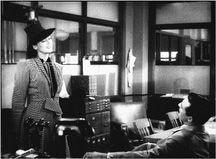
5.144 In
His Girl Friday,
when Hildy crosses from the left …
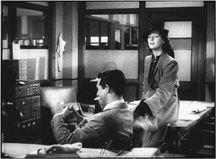
5.145 … to sit on a desk, the camera pans right to reframe her …
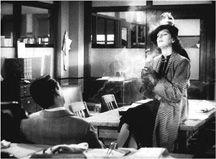
5.146 … and when Walter swivels his chair to face her, the camera reframes slightly leftward.
Reframing is only one way that the mobile frame may depend on figure movement. The camera may also displace itself in order to follow figures or moving objects. A camera movement that is more than just a reframing and that follows a figure’s movement is called—logically enough—a
following shot
(see
5.203
–
5.204
,
5.210
–
5.211
, and
5.215
–
5.224
). A pan may keep a racing car centered, a tracking shot may follow a character from room to room, or a crane shot may pursue a rising balloon. In such cases, frame mobility functions primarily to keep our attention fastened on the subject of the shot, and it subordinates itself to that subject’s movement.
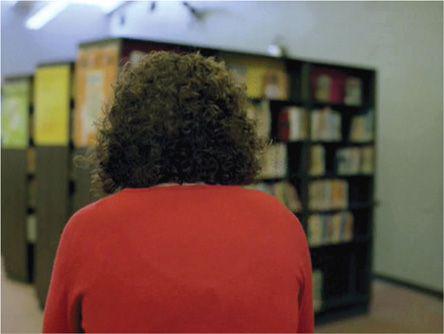
5.203 In a shot lasting two minutes, the camera follows Michelle into the library, where she starts reshelving books. Many of the long takes in
Elephant
frame the walking characters from behind. This conceals their facial expressions from us and emphasizes the school environment they move through.
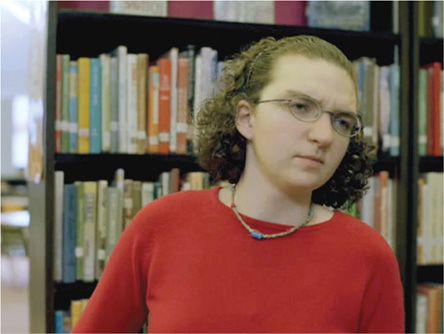
5.204 Michelle turns as we hear a rifle being cocked.